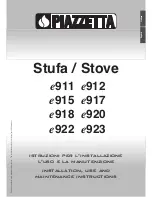
18
Cast Iron Fret Installation
Fret Retainer Brackets Installation
Screw 2 thumbscrews into sides of each support
leg if not done previously when support legs were
installed. Fit the slotted holes in the fret retainers over
the thumbscrews, push fret retainers downwards and
tighten screws.
Cast Iron Fret Installation
Adjust screw heads on back of fret to the thickness of
the retainer bracket and drop the fret into place while
guiding the screw heads into the slots in the bracket.
Clip the ash pan cover onto the fret.
Drop Fret with Bolt
into Slotted Retainer
(fret adjusts up or down
to suit)
Note: The fret retainer brackets are designed to
maintain the required space in front of the window to
allow the window to move and relieve during a hard
start.
It is very important to ensure this area in front
of the window is kept clear at all times.
Slip Fret Retainer
over thumbscrews
and tighten screws
Operation Check and Aeration Adjustment
Turn the fireplace up and down using the remote control to confirm
that the full range of inputs is achieved.
Light the fire and allow to warm up for 10–15 minutes to evaluate
the flame picture.
The burner is equipped with an adjustable air
shutter to control primary aeration. See figures below. The shutter is
factory-set at an aeration gap, which will give optimum performance
for the vast majority of installations. In a few unusual installations,
flame picture may be improved by adjusting the aeration. The need
for adjustment should be determined only by operating the appliance
with the ceramic fuel effects and window installed.
Increasing aeration
will cause the flame to appear more
transparent and blue making the ceramic fuel effects glow more.
Decreasing aeration
will
cause the flames to appear
more yellow or orange making
the fuel effects glow less.
Too little aeration may result
in black carbon forming and
dropping into the firebox.
Air Shutter in
Open Position
Air Shutter in
Closed Position
Air Shutter
Air Shutter Retainer
Air Shutter Components











































